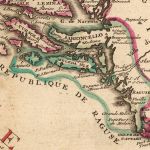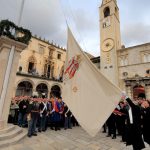Ever heard of the ”Croatan” Indians? Dubrovnik’s history goes not only deeper, but stretches much, much further than you’d imagine…
Rodoslovlje brings us an interesting story, have you ever heard of the Croatian (Croatan) Indians from North Carolina?
Dubrovnik’s ”Karakas” which sailed under the city’s famous flag of St Blaise (Sveti Vlaho) (to which the English referred as Argosy) were among the largest and safest vessels of their time. Despite their relative safety, it is well known that a shipwreck occurred in the year 1541 at Cape Hatteras in North Carolina, where the crew mixed with the local Indian population. (Suad Ahmetović, 1977).
Two well-equipped ships left Dubrovnik on a journey across the ocean and never, ever returned home to the city. One of the captains on board one of the vessels is known to have been a Dubrovnik local named Đuro Lovrić. The masters (shipbuilders) of Dubrovnik were among the most skillful shipbuilders of the 15th century, and the Karaka was constructed to be able to carry weapons, up to 40 cannons, with a crew consisting of up to 140 sailors, three masts and much more. They soon expanded their ability to transport up to 1000 soldiers and load up to 900 tons, and over time they continued to improve them in every possible practical respect. The Dominican monastery in Dubrovnik still preserves the most valuable specimen of Dubrovnik’s Karaka from the XV. century, as well as numerous other examples of the city’s incredible shipbuilding designs to this very day.
Dubrovnik’s Karakas were welcomed into numerous war and exploration expeditions far and wide, all over the Earth’s vast oceans, so it was relatively well-known that in many activities undertaken by the formidable Spanish Armada, many Dubrovnik natives (Croati) participated, and that is why some of Dubrovnik’s then admirals and captains ended up being granted a multitude of enviable privileges.
The most famous Dubrovnik admiral families of the time, more precisely from the XI. until the 16th century were: Bunić (i) Bona, Crijević, Držić, Gundulić, Vetranović, Miloslavić, Lovrić, Gojisalić, Kranković and Đurinić. Many of these surnames had disappeared in Dubrovnik until now, and Bunić, Držić, Gundulić and Vetranović allegedly no longer exist in Dubrovnik, with some other surnames of the kind facing extinction.
According to the data presented by the academic Nenad Vekarić, of 126 ”samples” of this local Dubrovnik genus, only three of these surnames experienced part of the 21st century on the former territory of the Dubrovnik Republic (Ragusa): Today, the Bona’s and the Gozzo’s still live in Dubrovnik, while the Sorgo family reside on the nearby island of Sipan, part of the Elaphite islands. (Domagoj Vidović, 2012.)
The navigational willingness of Dubrovnik’s talented seafarers is confirmed by the existence of the textbook entitled “De navigatione” written in the year 1464 by Benedict Kotruljević, which is the first known navigational manual in the entire history of Europe. It’s also worth mentioning that its occurrence was recorded approximately thirty years before the discovery of America. (Darko Žubrinić, 1995).
Josip Cuculić, who moved to the United States from Dubrovnik in 1936, has explored the history and the emergence of ”Croatan” Indians in America in depth. He finds many provable sources about which he first read in a library in one hundred-page-old American-made book by an American officer with an unreadable name, in which he noticed a great similarity between very many Indian and Croatian words:
Yonoke – junak (hero)
Wissakae – visok (tall)
Wissakae yonoke – visoki heroj (high hero, big hero)
Pita – pita (sweet bread)
Strachey achanahawen – strašni oceanski kamen (hard ocean rock, the type to cause damage to a ship)
Mojno – mirno (calm, peaceful)
Tar – star (old)
Nause – naše (ours)
Riba-kon – riba ili ribarenje (fish or fishing)
Many others also exist, and none of these words have anything to do with the Indian language.
The geographers of that time didn’t yet realise that the new continent, America, had been discovered, but genuinely believed that they had stumbled upon India. The descendants born of the mixing of the people of Dubrovnik and the local Indian population were referred to as the ”Croatan Indians”, done so in accordance with geographical references to individuals used in the past and still very much used today in modern Croatian language: Croat – Croatan, Ragusa – Ragusan, just like Splićan (somebody from Split), Hvaran (somebody from Hvar), Dubrovčan (somebody from Dubrovnik), Zagrepčan (somebody from Zagreb), and so on. Eventually, as time passed, the Croatan Indians mixed with various other newcomers.
On numerous family photos of these people, kids with classic European features such as blonde and chestnut hair can be clearly seen, and the very same appearance of their ancestors was written about by many early sailors in the expeditions that were carried out during the sixteenth century.
Details from the first English expedition which took place under Adams and Barlow near Cape Hatteras, recalls the white-skinned Indian children and part of the native people who they discovered had, many years ago, already been in contact with white people who had become shipwrecked and ended up remaining there living with them. During their two-month stay, the English set up a colony and left behind them a group of settlers. Two Indians went back to England with the English explorers, who surprised those at home in London with their behaviour and quick ability to learn the language. They returned back home under the care of Admiral Greenville on July the 3rd, 1585.
This article opens up numerous paths for new investigations that were not possible to write about: such as religious links, numerous genetic examinations, more accurate linguistic proof of Indian words discovered similar to both Croatian words and the old Dubrovnik dialect, genealogical tests, such as, for example, the surnames Lovrić and Lowrie…
Particularly interesting is the Indian religious inscription – as in ancient times their Great Spirit Manitou was referred to as the White Prophet from the East, a brave leader who was called the Wissakae Yunoke (Visoki Heroj/High Hero), who allegedly taught the Indians about morale, honour and various other skills.
This text is merely a modest attempt to prove the legitimacy and truth behind the tales of the existence of Croatian (Croatan) Indians. (Ivo Šišević, 1976). Among Croatan Indians today, only about 2% of those have, by genetic testing, been confirmed to be of Croatian origin.
There are several interesting surnames to be noted too: Potkin, Barba(r), Burrus/Burras (Bura?), Robb, Barret (Bare), Basnet (Basne) and some very interesting and almost obvious ones such as Garrish (Garić), Sutton (Suton) and the list goes on.
Despite everything written here at home in Croatian newspapers, you’re more likely to find more frequent records about the Bermuda Triangle, than of the possible ancient ”Croats” from North Carolina. Therefore, the stories of the Croatan Indians should be preserved as gems on the palms of Croatia’s hands and, with the help of further and more in-depth research, be firmly embedded into the deeply woven embroidery of Croatia’s long and interesting history.
SOURCES:
Rodoslovlje.hr – Božidar Ručević
Suad Ahmetović, Croatan Indians – Descendants of old Dubrovnik, Zagreb: Vjesnik (1977)
Adam S. Eterovich, Croatia and the Croats and the Lost Colony, San Carlos: Ragusan Press, Ca. (2003)
Ivo Juric, Origins of Croats. Genetic evidence of autochthonousness. Zagreb: Nova stvarnost (New reality) – Institut Pilar (2011.)
Benedikt Kotruljević, De Navigation, 1464
Tomislav Kukec, Croats Colonised North America in the 16th Century, Zagreb: Jutarnji List (June 24, 2012)
Božidar Ručević, The oldest pedigree in Croats, Zagreb: Rodoslovlje.hr, (2012)
Vladimir Stipetić and Nenad Vekarić, Historical Demography of Croatia, Zagreb Dubrovnik: HAZU (2004)
Petar Šimunović, Croatia Surname, Zagreb: Golden marketing-Tehnička knjiga, (2006)
Ivo Šišević, Croatian Indians, Trace of Historical Data and Some Language Traces. Dubrovnik: Maritime Journal – Naše more (1976)
Nenad Vekarić, City of Dubrovnik, Zagreb – Dubrovnik: HAZU, St. I. (2011), vol. II. (2012)
Aleksandar Veljić, Indians of the Croatian name. Brodolomci iz Dubrovnika. Zagreb: Studio (1977)
Domagoj Vidović, Surname as a reflection of cultural heritage on the example of Dalmatia, Zagreb: www.rodoslovlje.hr (18.5.2012.)
Wikipedija, Dubrovnik and USA (April 20th, 2012)
Darko Žubrinić, Croatian Marines in the New World, Zagreb (1995)









